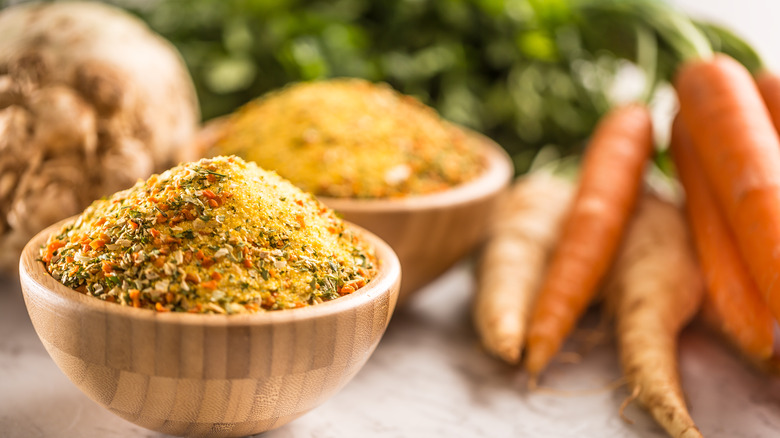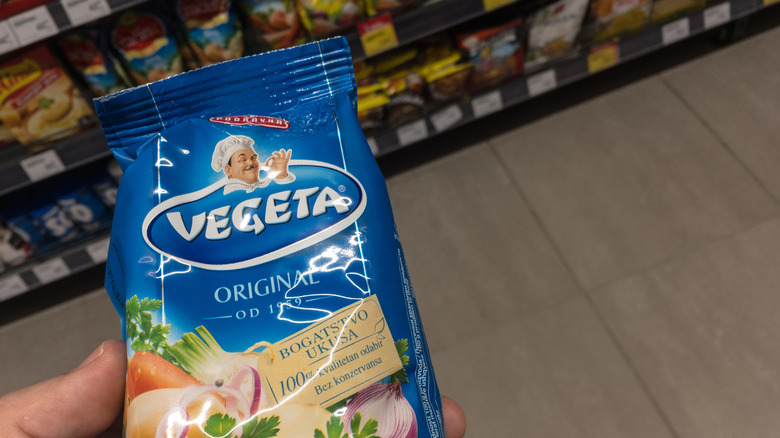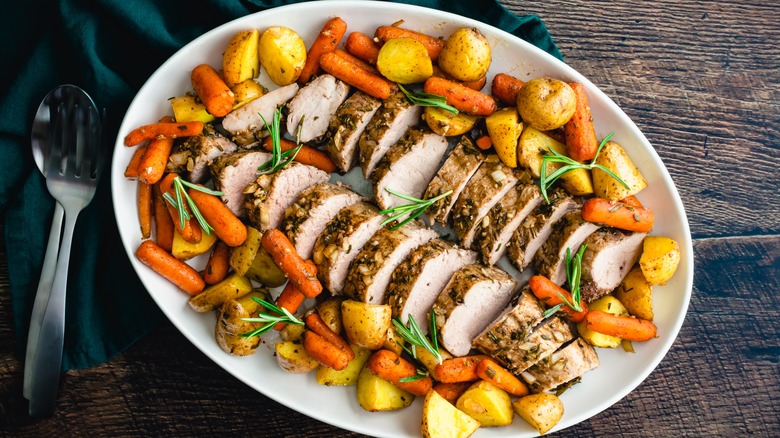Vegeta Is The Savory Seasoning That'll Elevate Even The Most Bland Meals
Don't let anyone convince you that concentrated seasonings are the cheater's answer to a home-cooked meal. Freshly chopped aromatic vegetables and manually crushed spices are nice, but shortcuts are a welcome (and economical) backup. Not only do they save time, but they also take up less space in your kitchen and can be used over and over again. We're talking about your Better Than Bouillon, your dashi packets, and your MSG — products that pack huge flavor into teaspoons and take savory dishes to the next level.
Those attuned to Croatian pantry essentials would be remiss if they didn't include Vegeta on that list. The seasoning blend is a mix of dried vegetables, salt, spices, and (for extra umami flavor) MSG. It's a must-have for soups, stews, and any other recipe that normally requires a mirepoix of carrot, celery, and onion. But where can you get your hands on some, and how should you use it once it's in your kitchen?
Mirepoix in a pinch
Vegeta (which happens to share a name with an iconic anti-hero from the "Dragon Ball" franchise) combines dehydrated carrot, parsnip, onion, potato, celery, parsley, black pepper, and nutmeg into one sprinkle-able product, bolstered by salt and MSG; there's also a version without MSG. Its most obvious application is soups, but you'd be hard-pressed to find a hearty, savory dish where it doesn't fit. On its website, Vegeta also claims that it adds "magic" and "mouth-watering savory complexity" to chicken, meat, seafood, stew, pasta, salad, and risotto.
Writing for Food Network, Michelle Baricevic mentions that she grew up eating dishes seasoned with Vegeta and claims that even "a small spoonful ... easily transforms any dish." She also notes that, unlike fresh vegetables, Vegeta can be added to a dish at any stage of cooking. Though it's mostly popular in Eastern Europe, you'll likely find it in the spices or "international" foods aisles of several supermarkets in the U.S., including Food Bazaar and Key Food.
Vegeta in the Croatian kitchen
We're not kidding when we say you can use Vegeta in pretty much any savory dish, but if you want to honor its Croatian roots, you might try your hand at some traditional applications from the land of Dalmatians. In honor of the product's 60th birthday, Total Croatia News highlighted some classic recipes, courtesy of the brand, that represent Croatian cuisine, including beef medallions "made the Dalmatian way" with slices of ricotta-like skuta cheese.
They also shout out stuffed pancakes à la sarma, which "marries the best of both worlds" by combining pancakes and stuffed grape leaves; Zagorje potato soup with dried bacon and sour cream; zucchini fritters; and peppers stuffed with creamy mashed potatoes. The seasoning also works beautifully in fish marinades.
You might try adding Vegeta to a batch of Skradin risotto, which once delighted Anthony Bourdain. Famous for its lengthy cook time (many versions take up to 10 hours and some can even simmer for half a day), the rice dish hails (and takes its name) from a town along the Krka River. It's traditionally made with veal as the main focus plus a variety of meats (ham, chicken, and beef), which is then topped with shavings of hard cheese usually made from sheep's milk like Paski Sir.
However you choose to use Vegeta, just be sure to start slow. You can always add more of the salty product, but you can't take it away.


